Discovery of N -Arylsulfonyl-Indole-2-Carboxamide Derivatives as Potent, Selective, and Orally Bioavailable Fructose-1,6-Bisphosphatase Inhibitors-Design, Synthesis, In Vivo Glucose Lowering Effects, and X-ray Crystal Complex Analysis.
Zhou, J., Bie, J., Wang, X., Liu, Q., Li, R., Chen, H., Hu, J., Cao, H., Ji, W., Li, Y., Liu, S., Shen, Z., Xu, B.(2020) J Med Chem 63: 10307-10329
- PubMed: 32820629
- DOI: https://doi.org/10.1021/acs.jmedchem.0c00726
- Primary Citation of Related Structures:
6LW2 - PubMed Abstract:
Liver fructose-1,6-bisphosphatase (FBPase) is a key enzyme in the gluconeogenesis pathway. Inhibiting FBPase activity represents a potential treatment for type 2 diabetes mellitus. A series of novel N -arylsulfonyl-4-arylamino-indole-2-carboxamide derivatives have been disclosed as FBPase inhibitors. Through extensive structure-activity relationship investigations, a promising candidate molecule Cpd118 [sodium (7-chloro-4-((3-methoxyphenyl)amino)-1-methyl-1 H -indole-2-carbonyl] [(4-methoxyphenyl)sulfonyl)amide] has been identified with high inhibitory activity against human liver FBPase (IC 50 , 0.029 ± 0.006 μM) and high selectivity relative to the other six AMP-binding enzymes. Importantly, Cpd11 8 produced significant glucose-lowering effects on both type 2 diabetic KKAy mice and ZDF rats as demonstrated by substantial reductions in the fasting and postprandial blood glucose levels, as well as the HbA1c level. Furthermore, Cpd118 elicited a favorable pharmacokinetic profile with an oral bioavailability of 99.1%. Moreover, the X-ray crystal structure of the Cpd118 -FBPase complex was resolved, which revealed a unique binding mode and provided a structural basis for its high potency and selectivity.
Organizational Affiliation:
Beijing Key Laboratory of Active Substances Discovery and Druggability Evaluation, Institute of Materia Medica, Chinese Academy of Medical Sciences and Peking Union Medical College, Beijing 100050, China.















